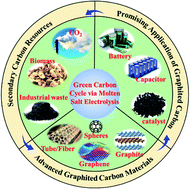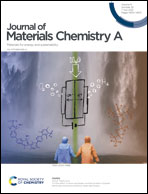Green and sustainable molten salt electrochemistry for the conversion of secondary carbon pollutants to advanced carbon materials
Abstract
Carbon emissions have caused serious climate changes such as global warming, glacier melting, and sea level rise. Carbon neutrality has become a global target and the sustainable disposal of carbon pollutants, such as CO2 and low value-added solid carbon wastes, is crucial to solve the climate problem. Expectedly, carbon pollutants are also considered as abundant secondary carbon resources for high value-added utilization. In the past decade, a green and sustainable molten salt electrochemical method has been innovatively developed to directly convert carbon pollutants to advanced graphitized carbon materials. It provides a promising and economic route for the value-added utilization of carbon pollutants to promote the impressive target of carbon neutrality. The electro-conversion mechanisms of CO2 and solid carbon resources to high value-added graphitized carbon materials are deeply discussed. The demands and the development status of inert anodes for molten salt electrochemistry are summarized. The micro-structure adjustment of carbon materials from CO2 is reviewed and the dependence of the graphitization degree is analyzed in detail. A preliminary application evaluation of CO2 electro-conversion in molten salt is carried out. The molten salt electrochemical graphitization conversion of low value-added solid carbon resources is summarized. Furthermore, the promising applications of carbon nanomaterials from carbon pollutants for batteries, supercapacitors, and catalysts are highlighted.



 Please wait while we load your content...
Please wait while we load your content...